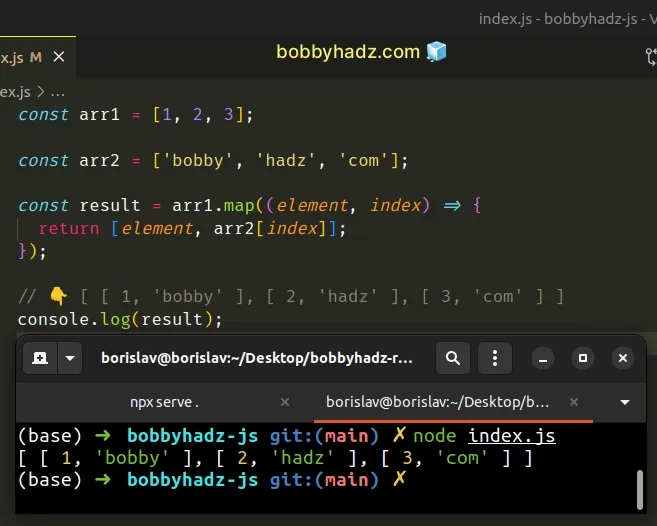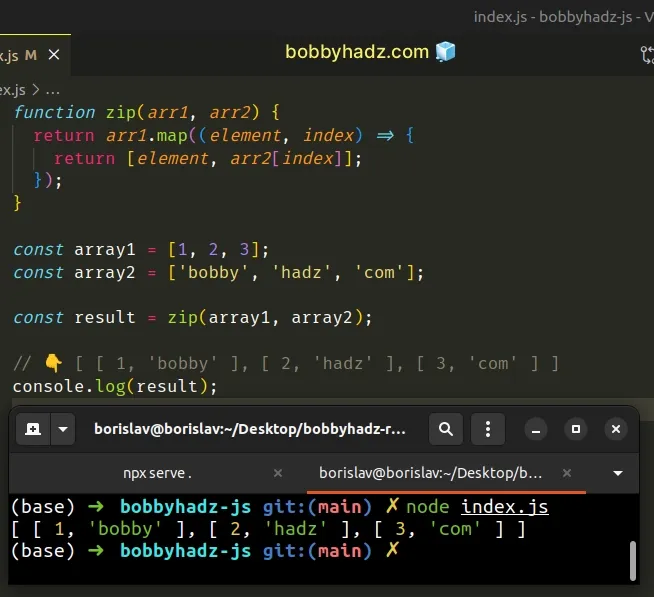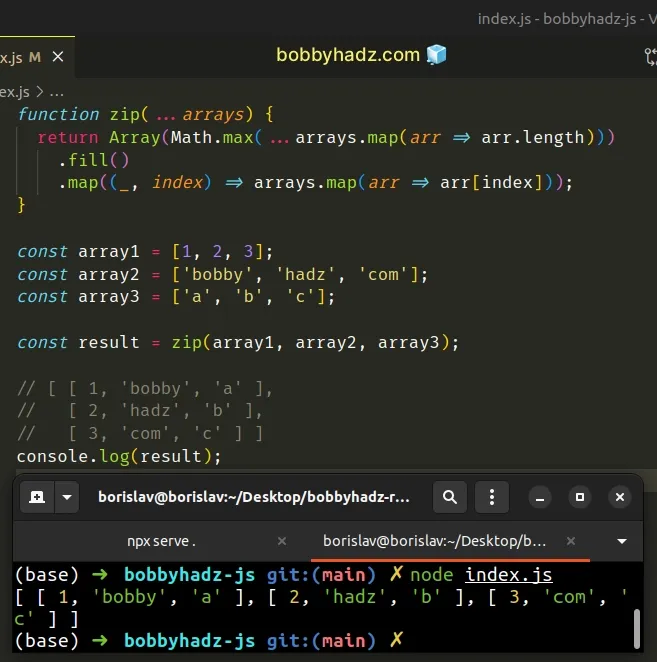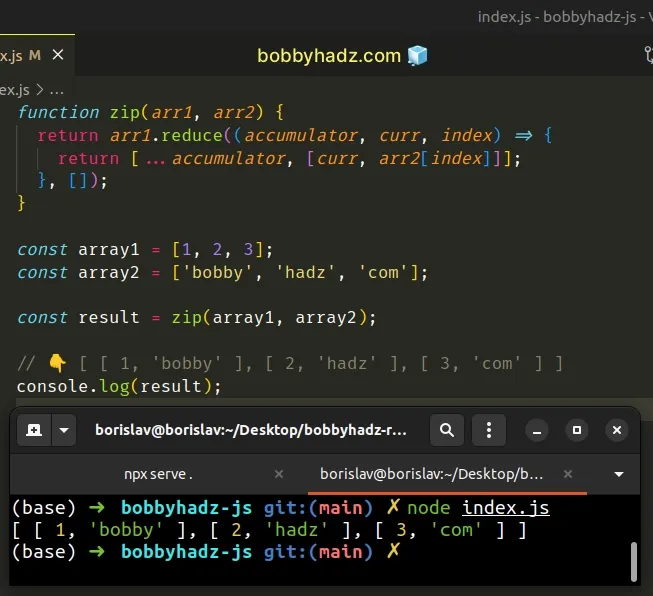How to Zip two or more Arrays in JavaScript - Complete Guide
Last updated: Mar 7, 2024
Reading time·6 min

# Table of Contents
- How to Zip two Arrays in JavaScript
- Defining a reusable zip() function
- Zip two arrays of different lengths
- Zip multiple arrays in JavaScript
- Zip two arrays in JavaScript using the reduce() method
- Zip two arrays in JavaScript using the forEach() method
- Zip two arrays in JavaScript using a for loop
# How to Zip two Arrays in JavaScript
To zip two arrays in JavaScript:
- Use the
Array.map()method to iterate over the first array. - On each iteration, return the current element and the corresponding element from the second array.
const arr1 = [1, 2, 3]; const arr2 = ['bobby', 'hadz', 'com']; const result = arr1.map((element, index) => { return [element, arr2[index]]; }); // 👇️ [ [ 1, 'bobby' ], [ 2, 'hadz' ], [ 3, 'com' ] ] console.log(result);

The function we passed to the Array.map() method gets called with each element of the first array.
We also make use of the index parameter.
On each iteration, we return a new array that contains the current element of the first array and the corresponding element of the second array.
The result is a two-dimensional array that contains subarrays where the first element is taken from the first array and the second element is taken from the second array.
You can also shorten this a little by using an implicit return statement.
const arr1 = [1, 2, 3]; const arr2 = ['bobby', 'hadz', 'com']; const result = arr1.map((element, index) => [ element, arr2[index], ]); // 👇️ [ [ 1, 'bobby' ], [ 2, 'hadz' ], [ 3, 'com' ] ] console.log(result);
This does the same as the Python zip() function which iterates over several iterables in parallel and produces tuples with an item from each iterable.
list1 = [1, 2, 3] list2 = ['bobby', 'hadz', 'com'] result = list(zip(list1, list2)) # 👇️ [(1, 'bobby'), (2, 'hadz'), (3, 'com')] print(result)
# Defining a reusable zip() function
If you have to zip two arrays often, define a reusable function.
function zip(arr1, arr2) { return arr1.map((element, index) => { return [element, arr2[index]]; }); } const array1 = [1, 2, 3]; const array2 = ['bobby', 'hadz', 'com']; const result = zip(array1, array2); // 👇️ [ [ 1, 'bobby' ], [ 2, 'hadz' ], [ 3, 'com' ] ] console.log(result);

The zip() function takes two arrays as parameters, zips the arrays and returns
the result.
# Zip two arrays of different lengths
When using this approach, you should consider the edge case where the arrays have a different length.
Here is an example where the first array is longer than the second array.
function zip(arr1, arr2) { return arr1.map((element, index) => { return [element, arr2[index]]; }); } const array1 = [1, 2, 3, 4]; const array2 = ['bobby', 'hadz', 'com']; const result = zip(array1, array2); // 👇️ [ [ 1, 'bobby' ], [ 2, 'hadz' ], // [ 3, 'com' ], [ 4, undefined ] ] console.log(result);

Accessing the second array at an index that doesn't exist returns undefined,
so the last subarray stores the values 4 and undefined.
However, if the first array has fewer elements than the second array, the remaining elements won't get added to the result.
function zip(arr1, arr2) { return arr1.map((element, index) => { return [element, arr2[index]]; }); } const array1 = [1, 2, 3]; const array2 = ['bobby', 'hadz', 'com', 'abc']; const result = zip(array1, array2); // 👇️ [ [ 1, 'bobby' ], [ 2, 'hadz' ], [ 3, 'com' ] ] console.log(result);
The first array has 3 elements and the second array has 4.
We only iterate over the first array, so the fourth element of the second array is never added to the zipped array.
If you want to produce a consistent result, create a new array that has a length equal to the larger of the two arrays and then iterate over it instead.
function zip(arr1, arr2) { return Array(Math.max(arr1.length, arr2.length)) .fill() .map((_, index) => [arr1[index], arr2[index]]); } const array1 = [1, 2, 3]; const array2 = ['bobby', 'hadz', 'com', 'abc']; const result = zip(array1, array2); // 👇️ [ [ 1, 'bobby' ], [ 2, 'hadz' ], // [ 3, 'com' ], [ undefined, 'abc' ] ] console.log(result);
We used the Math.max() method to get
the length of the larger array and used the map() method to iterate over the
new array.
On each iteration, we access the arrays at the current index and return a new array containing the two values.
Now all array elements are guaranteed to be contained in the zipped array regardless if the first array is longer than the second or vice versa.
# Zip multiple arrays in JavaScript
If you need to zip multiple arrays in JavaScript:
- Use the
Math.max()method to get the length of the longest array. - Use the
Array()constructor to create an array of the given length. - Use the
map()method to iterate over the new array. - On each iteration, access the subarray at the current index and return the result.
function zip(...arrays) { return Array(Math.max(...arrays.map(arr => arr.length))) .fill() .map((_, index) => arrays.map(arr => arr[index])); } const array1 = [1, 2, 3]; const array2 = ['bobby', 'hadz', 'com']; const array3 = ['a', 'b', 'c']; const result = zip(array1, array2, array3); // [ [ 1, 'bobby', 'a' ], // [ 2, 'hadz', 'b' ], // [ 3, 'com', 'c' ] ] console.log(result);

Notice that we used the ...gather operator in the function's definition.
The operator gathers the supplied arrays into a new array.
Here is an example that demonstrates how this works.
function zip(...arrays) { // [ [ 1, 2, 3 ], // [ 'bobby', 'hadz', 'com' ], // [ 'a', 'b', 'c' ] ] console.log(arrays); } const array1 = [1, 2, 3]; const array2 = ['bobby', 'hadz', 'com']; const array3 = ['a', 'b', 'c']; const result = zip(array1, array2, array3);
Notice that the ... operator simply gathers the arrays into a new array.
The next step is to use the Math.max() method to get the length of the longest
array.
return Array(Math.max(...arrays.map(arr => arr.length))) .fill() .map((_, index) => arrays.map(arr => arr[index]));
Once we create a new array of the given length, we use the .map() method to
iterate over the array.
On each iteration, we use the map() method to iterate over the two-dimensional
array that we previously gathered using the ... syntax and return the subarray
element at the current index.
This implementation of the zip() function can be used to zip as many arrays as
necessary.
function zip(...arrays) { return Array(Math.max(...arrays.map(arr => arr.length))) .fill() .map((_, index) => arrays.map(arr => arr[index])); } const array1 = [1, 2, 3]; const array2 = ['bobby', 'hadz', 'com']; const array3 = ['a', 'b', 'c']; const result = zip(array1, array2, array3); // [ [ 1, 'bobby', 'a' ], // [ 2, 'hadz', 'b' ], // [ 3, 'com', 'c' ] ] console.log(result);
# Zip two arrays in JavaScript using the reduce() method
You can also use the Array.reduce method to zip two arrays in JS.
function zip(arr1, arr2) { return arr1.reduce((accumulator, curr, index) => { return [...accumulator, [curr, arr2[index]]]; }, []); } const array1 = [1, 2, 3]; const array2 = ['bobby', 'hadz', 'com']; const result = zip(array1, array2); // 👇️ [ [ 1, 'bobby' ], [ 2, 'hadz' ], [ 3, 'com' ] ] console.log(result);

We initialized the accumulator variable to an empty array because that's what
we passed as the second argument to the reduce() method.
On each iteration, we use the spread syntax (...) to unpack the accumulator array into a new array and add the current elements from the two arrays.
# Zip two arrays in JavaScript using the forEach() method
Alternatively, you can use the Array.forEach method.
function zip(arr1, arr2) { const zipped = []; arr1.forEach((element, index) => { zipped.push([element, arr2[index]]); }); return zipped; } const array1 = [1, 2, 3]; const array2 = ['bobby', 'hadz', 'com']; const result = zip(array1, array2); // 👇️ [ [ 1, 'bobby' ], [ 2, 'hadz' ], [ 3, 'com' ] ] console.log(result);
The function we passed to the Array.forEach() method gets called with each
element and index from the array.
On each iteration, push a new array into the zipped array.
The array contains the current element and the corresponding element from the second array.
# Zip two arrays in JavaScript using a for loop
You can also use a simple for loop to zip two arrays.
function zip(arr1, arr2) { const zipped = []; for (let index = 0; index < arr1.length; index++) { zipped.push([arr1[index], arr2[index]]); } return zipped; } const array1 = [1, 2, 3]; const array2 = ['bobby', 'hadz', 'com']; const result = zip(array1, array2); // 👇️ [ [ 1, 'bobby' ], [ 2, 'hadz' ], [ 3, 'com' ] ] console.log(result);
The syntax for a basic for loop is quite verbose compared to the
Array.forEach() method, however, the concept is the same.
We iterate over the first array and push a new array containing the current
elements from the two arrays into the zipped array.
Which approach you pick is a matter of personal preference. I'd use the
Array.map() method as I find it quite direct and intuitive.
# Additional Resources
You can learn more about the related topics by checking out the following tutorials:
- Create an Array containing 1 to N numbers in JavaScript
- Create an Array with N elements, same Value in JavaScript
- Create an Object from Two Arrays in JavaScript
- Filter an Array with Multiple Conditions in JavaScript
- Filter an Array to only Numbers in JavaScript
- Filter an Array of Objects based on a property is JavaScript
- How to iterate over a FileList in JavaScript [5 Ways]
- Resource interpreted as stylesheet but transferred with MIME type text/html
- How to skip over an Element or an Index in .map() in JS
- How to press the Enter key programmatically in JavaScript

